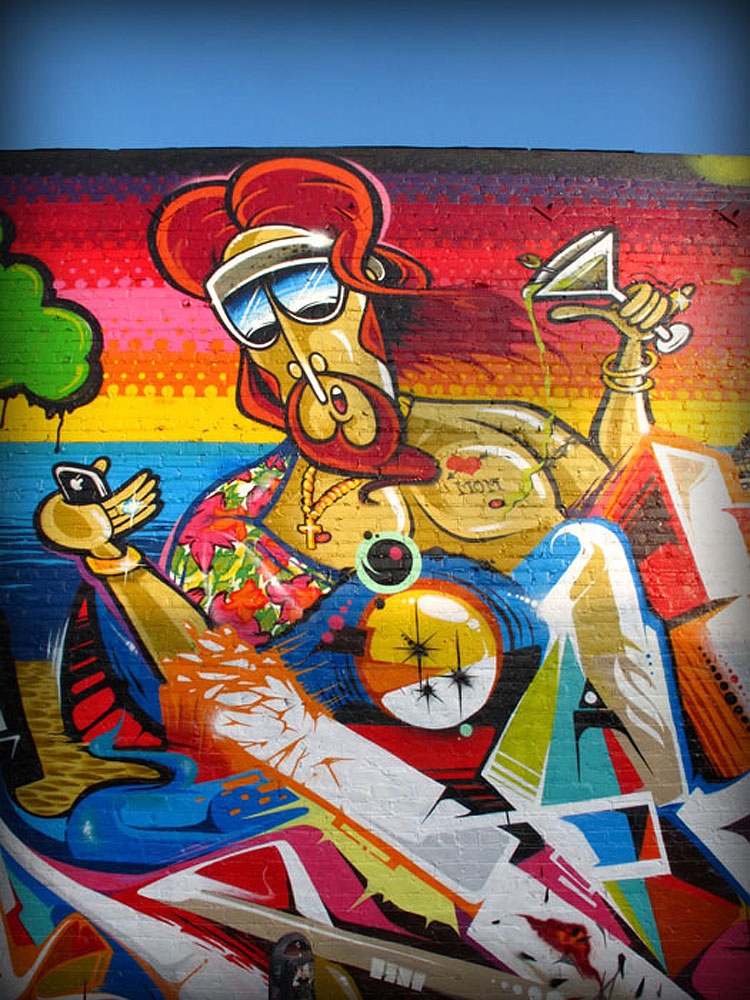-by SIMONE WILSON of the LA Weekly
Back when L.A. graffiti artist Sight was a teenager, he began slipping out of his mom’s South Central home late at night, armed with a razor blade or a can of spray paint, to claim the city’s surfaces as his own.
“When you go out in the nighttime, there’s nobody out there,” he recalls. “There’s a full moon; the air’s crisp. I’m with just me and my thoughts. It’s a beautiful experience.”
Marilyn Avila, Sight’s high school sweetheart and, now, the mother of his two children — 6-month-old Sofia and 18-month-old Adam — says, “I saw how happy it made him. It almost freed his mind.”
Sight was so prolific in his early days that he was known by peers, and graffiti watchers at large, as the “King of South Central.”
Avila recalls: “We would get on the bus, and if there was other graf artists in there, he would know almost all of them. If not, he’ll be, like, ‘Oh, I’m Sight,’ and they’ll be, like, ‘What?! You’re Sight?!’ ”
By the time the young vandal began attending Los Angeles City College, though, he claims he didn’t have time for the all-night branding sprees of his adolescence. He was working two jobs on top of journalism classes, and drove a car instead of riding and cutting up windows on the bus.
When he did break out the spray paint, says Sight, now 30, he had evolved from bus scribing and tagging to throwing up (spray-painting his name in big bubbly letters) and piecing (collaborating with friends on complex, mural-type works). His code of ethics was: “We’re not going to write on anything that looks good. We’d look for abandoned buildings, and walls that were really tagged up. We’d want to put some color right there.”
Along with his dream of becoming a journalist, Sight hoped to publish poetry and learn to piece like Saber and Revok, his heroes in the legendary Mad Society Kings (MSK) crew.
“It was like springtime,” he says of the early 2000s. “Everything was blossoming — there was so much potential.
“Now, it’s wintertime.”
In 2006, Sight was handed the harshest sentence any artist or law enforcement official can recall for graffiti vandalism: Eight years and four months in state prison.
Released after four years for good behavior, he’s perhaps the most dramatic casualty to date in L.A.’s war on street art — a multipronged effort that views young graffiti artists as public enemy No. 1 and has destroyed even those graffiti-style murals painted with full consent of building owners. As galleries and museums increasingly recognize the movement’s artistic value, government officials only become more determined to wipe it from the streets.
Sight — a short, burly black man with a fuzzy beard and a gentle disposition — had and has no record of violence. “He gets mad at me if I kill a spider,” his girlfriend says.
From the couple’s one-bedroom apartment in South Central, Sight relives the morning the cops came for him: Ten to 15 deputies busted into his grandmother’s house with “laser guns and body armor,” he says, barking at him to hand over his drugs and weapons. Finding none, they took his paint and his poetry books, Sight says.
Because Sight’s most expensive — and thus felonious — damage was beyond the five-year statute of limitations, he says, police asked him to date evidence photos of his graffiti “for a more recent date,” in return for which, they told him, “ ’We’ll let you go and get you probation.’ ”
Sheriff’s deputy Devin Vanderlaan, who investigated Sight, calls his accusation “absolutely ridiculous.” UPN member Tahoe claims the same happened to him.
Sight would spend a one-year stint alongside rapists and murderers at Folsom State Prison, where he says fellow inmates almost killed him for hanging back during a race riot. But worse than hard-core Folsom was L.A. County Sheriff Lee Baca’s own Men’s Central Jail, where Sight says that, among other degradations, he saw prison guards break the fingers of inmates who misbehaved.
Today, two years after his release, with 10 unusual “felony” counts for nonviolent vandalism on his permanent record, Sight can’t even get a job as a dishwasher. He says he’s filled out hundreds of job applications, but potential employers won’t believe that spraying paint on walls or etching one’s name onto bus panels could lead to felony charges in America.
“They think I blew up cars or smashed out windows or something,” Sight says. “They think I’m a terrorist.”
To believe Metro’s version of the damage Sight did to L.A., he nearly was. They claimed he caused $70,000 in damage, on the basis that each Metro window or metal panel he etched was replaced. In fact, bus windows often are sanded down by graffiti-abatement crews — and tend to be marred by tagger upon tagger long before parts are actually replaced — but the exaggerated cost claims play well in court.

Reblogged this on Adiek84's Blog.
Yo Rime it’s Slie Tits crew. You are an inspiration brother. I would love to be a part of something as amazing as you and your movement. True style mater! Hit me up if your ever in Austin Texas slieandco@gmail.com take it easy homie.